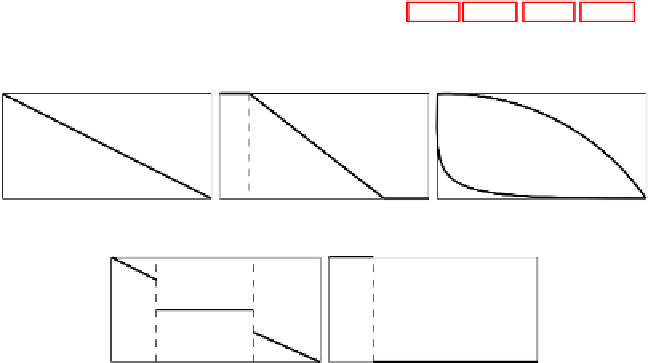Information Technology Reference
In-Depth Information
(a) and (b) say that 0 is completely small, and that 10 is not small at all. (c) says that
function
μ
S
shall be decreasing, and (d) says that no jumps to zero are allowed for
μ
S
. Some of those functions are depicted in figures 15.1a, 15.1b, 15.1c, 15.1d.
(a) linear model
(b) picewise linear model
(c) non-linear models
(d)
picewise
linear
with
(e) not allowed jumps
jumps
Fig. 15.1
Obviously no function like that in figure 15.1e is allowed to represent 'small',
that is, no
precisification
of the grade of 'small' by a classical predicate like 'less
than s' is permitted by the use given by the former four rules.
15.3.2
Once one of those functions
μ
S
is taken as adequate to represent how 'small' is be-
ing used in a concrete case, it is supposed that also, the use of 'not small' should
be known, that is, a strong negation function
N
:
[
0
,
1
]
→
[
0
,
1
]
is known to ver-
)) =
ϕ
−
1
ify
μ
notS
(
x
)=
N
(
μ
S
(
x
(
1
−
ϕ
(
μ
S
(
x
)))
,forall
x
in [0,10], with an order-
antomorphism
ϕ
of the totally ordered unit interval [4]. Notice that it is
N
(
n
)=
n
,
=
ϕ
−
1
(
/
)
∈
(
,
)
if an only if n
1
2
0
1
, hence it is:
)
≥
ϕ
−
1
μ
S
(
x
)
≥
μ
notS
(
x
)
⇔
μ
S
(
x
(
1
/
2
)
,
and then the
Kernel
of
μ
S
is defined by:
)
≥
ϕ
−
1
K
N
(
μ
S
)=
{
x
∈
[
0
,
10
]
;
μ
S
(
x
)
≥
μ
notS
(
x
)
}
=
{
x
∈
[
0
,
10
]
;
μ
S
(
x
(
1
/
2
)
},
that is,
K
N
(
μ
P
)
is the subset of [0,10] containing those
x
that are 'more
S
than not
S
'. Of course, it exists
s
, a value that can be identified with
a kind of separation point in a similar sense to that of Max Black since any
s
=
SupK
N
(
μ
S
)
∈
[
0
,
10
]
+
ε
is
'more' not
S
than
S
.


